Mutibranding Strategy - Gap Inc
Branding is a crucial aspect of marketing. Defined as, "any word, device (design, sound, shape, or color), or combination of these used to distinguish a seller's products or services (Keren, McGraw-Hill), branding can take many forms. A rather interesting kind of branding is the multi branding strategy. A company can do this by giving each product a distinct name, which is useful when each brand is intended for a different market segment (Keren, McGraw Hill).
A great example of this is Gap Inc., which has numerous brands, the most popular being Old Navy, Gap, Banana Republic, Athleta, and Intermix. Old Navy and Gap are the day-to-day style clothing, Banana Republic is mostly business casual and professional, Athleta is athleisure, and, lastly, Intermix is higher-end, luxury clothing. With $16 billion in revenue in fiscal year ended February 1, 2020, it is clear that this multi branding strategy is paying off.
 |
| An example of Gap Inc. grouping brands |
Companies can use a multi branding strategy to diversify. This is a great tool when the different brands are marketed towards different customers. Between their brands, Gap Inc. reaches the majority of American consumer demographics. In addition, this protects against certain products becoming less desirable to consumers. An example of this is following the stay at home orders of the pandemic. The company noticed a shift in the profitability of their brands. Sales at Banana Republic, which sells suits, knits, and general business clothing, fell (Bloomberg.com).
On the other hand, Athleta, their athleisure retailer, saw a 6% increase last quarter (Bloomberg.com). This is largely due to the stay at home nature of the pandemic, as well as customers going into the office less, thus ditching business uniforms and craving comfort. In addition, sales at Old Navy, which is the most affordable of the brands, remained stronger through the pandemic, demonstrating how diversifying to meet differing consumer needs is a fruitful strategy. As shown below, Old Navy and Athleta were major players and keeping the company afloat during this shift, primarily through online sales during store closures.
 |
| Source: Bloomberg.com, from Gap Inc. statement |
Overall, Gap Inc. is a great example of how utilizing a multi branding strategy to create differentiation can benefit a company. Through their seven brands, Gap Inc. has been able to meet the needs of almost every customer demographic, from affordable, every day clothing, to slightly more affordable business casual, to luxury, high-end options at Intermix. Not only does this cast a wide net and increase the types of customers, it also protects against certain customers falling off, as seen through the pandemic. Lastly, Gap Inc. knows how to market their brands both together and seperately, which does make it a unique case in terms of the multi branding strategy.
I've attached the link to their site if you'd like to dive in further!
As always, Liv(e) Fashion Forward.
Citations
Bloomberg.com, Bloomberg, www.bloomberg.com/news/articles/2020-08-27/gap-reports-quarterly-sales-fell-less-than-anticipated.
Kerin, Roger A., and Steven W. Hartley. Marketing: the Core. McGraw-Hill Education, 2019.


Comments
Post a Comment